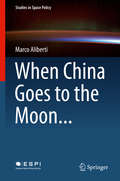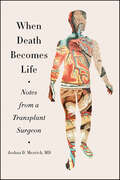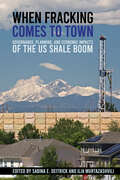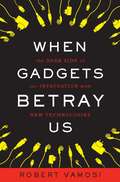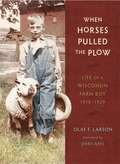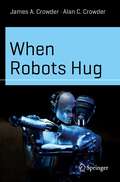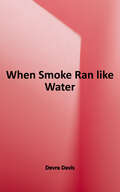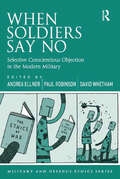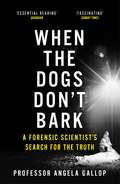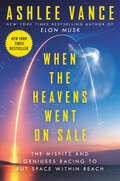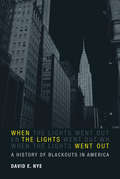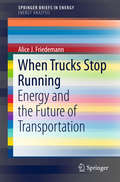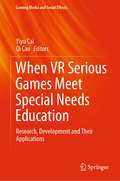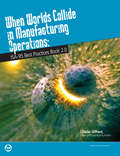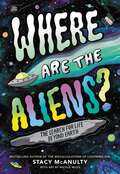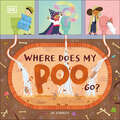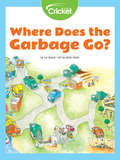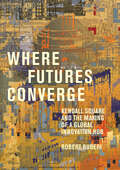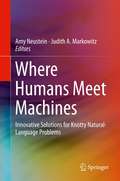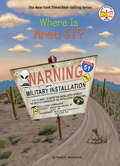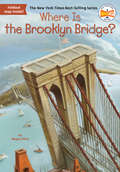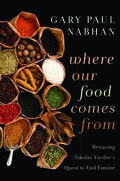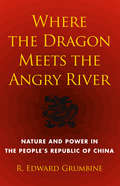- Table View
- List View
When China Goes to the Moon...
by Marco AlibertiThis book is about China's ambitions in its most complex and internationally visible space endeavor, namely its human space exploration programme. It provides a comprehensive reflection on China´s strategic direction and objectives in space, including in particular those set forth in its human spaceflight programme and analyses the key domestic and external factors affecting the country's presumed manned lunar ambitions. The objective of the book is to disentangle the opportunities and challenges China´s space ambitions are creating for other spacefaring nations and for Europe in particular. It therefore includes an in-depth analysis of possible European postures towards China in space exploration and seeks to stimulate a debate on future space strategies in the broader context of world politics.
When Death Becomes Life: Notes from a Transplant Surgeon
by Joshua D. Mezrich"With When Death Becomes Life, Joshua Mezrich has performed the perfect core biopsy of transplantation—a clear and compelling account of the grueling daily work, the spell-binding history and the unsettling ethical issues that haunt this miraculous lifesaving treatment. Mezrich's compassionate and honest voice, punctuated by a sharp and intelligent wit, render the enormous subject not just palatable but downright engrossing."—Pauline Chen, author of Final Exam: A Surgeon’s Reflections on MortalityA gifted surgeon illuminates one of the most profound, awe-inspiring, and deeply affecting achievements of modern day medicine—the movement of organs between bodies—in this exceptional work of death and life that takes its place besides Atul Gawande’s Complications, Siddhartha Mukherjee’s The Emperor of All Maladies, and Jerome Groopman’s How Doctors Think. At the University of Wisconsin, Dr. Joshua Mezrich creates life from loss, transplanting organs from one body to another. In this intimate, profoundly moving work, he illuminates the extraordinary field of transplantation that enables this kind of miracle to happen every day.When Death Becomes Life is a thrilling look at how science advances on a grand scale to improve human lives. Mezrich examines more than one hundred years of remarkable medical breakthroughs, connecting this fascinating history with the inspiring and heartbreaking stories of his transplant patients. Combining gentle sensitivity with scientific clarity, Mezrich reflects on his calling as a doctor and introduces the modern pioneers who made transplantation a reality—maverick surgeons whose feats of imagination, bold vision, and daring risk taking generated techniques and practices that save millions of lives around the world.Mezrich takes us inside the operating room and unlocks the wondrous process of transplant surgery, a delicate, intense ballet requiring precise timing, breathtaking skill, and at times, creative improvisation. In illuminating this work, Mezrich touches the essence of existence and what it means to be alive. Most physicians fight death, but in transplantation, doctors take from death. Mezrich shares his gratitude and awe for the privilege of being part of this transformative exchange as the dead give their last breath of life to the living. After all, the donors are his patients, too.When Death Becomes Life also engages in fascinating ethical and philosophical debates: How much risk should a healthy person be allowed to take to save someone she loves? Should a patient suffering from alcoholism receive a healthy liver? What defines death, and what role did organ transplantation play in that definition? The human story behind the most exceptional medicine of our time, Mezrich’s riveting book is a beautiful, poignant reminder that a life lost can also offer the hope of a new beginning.
When Fracking Comes to Town: Governance, Planning, and Economic Impacts of the US Shale Boom
When Fracking Comes to Town traces the response of local communities to the shale gas revolution. Rather than cast communities as powerless to respond to oil and gas companies and their landmen, it shows that communities have adapted their local rules and regulations to meet the novel challenges accompanying unconventional gas extraction through fracking. The multidisciplinary perspectives of this volume's essays tie together insights from planners, legal scholars, political scientists, and economists. What emerges is a more nuanced perspective of shale gas development and its impacts on municipalities and residents. Unlike many political debates that cast fracking in black-and-white terms, this book's contributors embrace the complexity of local responses to fracking. States adapted legal institutions to meet the new challenges posed by this energy extraction process while under-resourced municipal officials and local planning offices found creative ways to alleviate pressure on local infrastructure and reduce harmful effects of fracking on the environment. The essays in When Fracking Comes to Town tell a story of community resilience with the rise and decline of shale gas production. Contributors: Ennio Piano, Ann M. Eisenberg, Pamela A. Mischen, Joseph T. Palka, Jr., Adelyn Hall, Carla Chifos, Teresa Córdova, Rebecca Matsco, Anna C. Osland, Carolyn G. Loh, Gavin Roberts, Sandeep Kumar Rangaraju, Frederick Tannery, Larry McCarthy, Erik R. Pages, Mark C. White, Martin Romitti, Nicholas G. McClure, Ion Simonides, Jeremy G. Weber, Max Harleman, Heidi Gorovitz Robertson
When Gadgets Betray Us: The Dark Side of Our Infatuation With New Technologies
by Robert VamosiWriting in plain language for general readers, Vamosi, a computer security analyst and a contributing editor at PCWorld, explains what we're really signing up for when we log in and reveals the secret lives of our electronic devices, offering a commonsense approach for protecting ourselves. The book is about hardware hacking and new kinds of identity fraud: how our mobile phone conversations can be intercepted, how our credit cards and driver's licenses can be copied at a distance. The author travels from the streets of New York and LA to Johannesburg and Berlin, to talk to people who have experienced firsthand how gadgets can betray us and to examine the effects of technology in the Third World. He recommends the addition of basic authentication and strong encryption to most hardware to reduce the vulnerabilities described in the book, but notes that hardware manufacturers have so far shown little interest in securing their gadgets. Annotation ©2011 Book News, Inc. , Portland, OR (booknews. com)
When Horses Pulled the Plow
by Olaf F. LarsonIn 1910, when Olaf F. Larson was born to tenant livestock and tobacco farmers in Rock County, Wisconsin, the original barn still stood on the property. It was filled with artifacts of an earlier time--an ox yoke, a grain cradle, a scythe used to cut hay by hand. But Larson came of age in a brave new world of modern inventions--tractors, trucks, combines, airplanes--that would change farming and rural life forever. <P> When Horses Pulled the Plow is Larson's account of that rural life in the early twentieth century. He weaves invaluable historical details--including descriptions of farm equipment, crops, and livestock--with wry tales about his family, neighbors, and the one-room schoolhouse he attended, revealing the texture of everyday life in the rural Midwest almost a century ago. This memoir, written by Larson in his ninth decade, provides a wealth of details recalled from an earlier era and an illuminating read for anyone with their own memories of growing up on a farm.
When Robots Hug (Science and Fiction)
by James A. Crowder Alan C. CrowderBy 2027, it had been seven years since the scientists’ sea-changing research on artificial psychology and robotics. The work debuted around the same time as Large Language Model Chatbots, and the power of the integration of the two technologies put many industries in a tailspin. The commercial and defense industries especially were still scrambling to regulate their use in research and universities. The sought-after scientists signed with DARPA to build reliable and secure AI entities, but the agency grew fearful of the technology’s power and ultimately decided it was too dangerous to bring to market and demanded the scientists destroy the work. The researchers couldn’t bring themselves to discard 20 years of research, so instead sent the entities to various research labs around the world. But unbeknownst to them, each AI-entity embraced its new home, growing, adapting, evolving, and ultimately connecting beyond what the researchers could envision. In the end, as the scientists catch up to each one, they realize the entities have discovered a very human means of interacting: the power of physical contact; and not physical contact between humans and technology, but physical contact between robotic entities. And with this discovery, the entities join forces to only grow stronger. This development ushers in a new paradigm where the difference between AI-entities and human entities becomes less and less discernible. All the AI and robotic science featured in the book is real; the story line is fictional, but with how fast innovation moves, it’s not hard to envision.
When Smoke Ran Like Water: Tales of Environmental Deception and the Battle Against Pollution
by Devra DavisIn this book, the world-renowned epidemiologist Devra Davis confronts the public triumphs and private failures of her lifelong battle against environmental pollution. She documents the shocking toll of a public-health disaster-300,000 deaths a year in the U.S. and Europe from the effects of pollution-and asks why we remain silent. For Davis, the issue is personal: Pollution is what killed many in her family and forced some of the others, survivors of the 1948 smog emergency in Donora, Pennsylvania, to live out their lives with impaired health. She describes that episode and also makes startling revelations about how the deaths from the London smog of 1952 were falsely attributed to influenza; how the oil companies and auto manufacturers fought for decades to keep lead in gasoline, while knowing it caused brain damage; and many other battles. The book makes a devastating case for change.
When Soldiers Say No: Selective Conscientious Objection in the Modern Military (Military and Defence Ethics)
by Paul Robinson David Whetham Andrea EllnerTraditionally few people challenged the distinction between absolute and selective conscientious objection by those being asked to carry out military duties. The former is an objection to fighting all wars - a position generally respected and accommodated by democratic states, while the latter is an objection to a specific war or conflict - theoretically and practically a much harder idea to accept and embrace for military institutions. However, a decade of conflict not clearly aligned to vital national interests combined with recent acts of selective conscientious objection by members of the military have led some to reappraise the situation and argue that selective conscientious objection ought to be legally recognised and permitted. Political, social and philosophical factors lie behind this new interest which together mean that the time is ripe for a fresh and thorough evaluation of the topic. This book brings together arguments for and against selective conscientious objection, as well as case studies examining how different countries deal with those who claim the status of selective conscientious objectors. As such, it sheds new light on a topic of increasing importance to those concerned with military ethics and public policy, within military institutions, government, and academia.
When the Dogs Don't Bark: A Forensic Scientist's Search for the Truth
by Professor Angela Gallop*As seen on ITV's The Pembrokeshire Murders*'Fascinating. A book that will be essential reading for every aspiring crime writer' Guardian'Offers a chilling glimpse into her life's work. Fascinating stuff.' Sunday Times 'Compelling' Daily Mirrror__________By the time I arrived at the wood yard in Huddersfield on a bitterly cold night in February 1978, the body of the 18-year-old victim had already been taken to the mortuary.__________Never before has criminal justice rested so heavily on scientific evidence. With ever-more sophisticated and powerful techniques at their disposal, forensic scientists have an unprecedented ability to help solve even the most complex cases. Angela Gallop has been a forensic scientist for over 40 years. After joining the Forensic Science Service, the first crime scene she attended was for a case involving the Yorkshire Ripper. As well as working on a wide range of cases in many countries around the world, she is now the most sought-after forensic scientist in the UK, where she has helped solve numerous high-profile cases, including the investigation that finally absolved the Cardiff Three the Pembrokeshire Coastal Path murders, and the killings of Stephen Lawrence, Damilola Taylor, Rachel Nickell and Roberto Calvi. From the crime scene to the courtroom, When the Dogs Don't Bark is the remarkable story of a life spent searching for the truth.'Fascinating' The Sun'a casebook that reads like The Encyclopedia Of Murder' Daily Express'One of the profession's leading lights' Woman & Home'The real life Silent Witness' Belfast Telegraph__________The compelling memoir from the UK's most eminent forensic scientist and some of the most fascinating criminal investigations she has worked on. You learnt about forensic pathology with Dr Richard Shepherd in Unnatural Causes and about anthropology with Professor Sue Black in All That Remains. Now it's time to learn about the scene of the crime. . .
When the Heavens Went on Sale: The Misfits and Geniuses Racing to Put Space Within Reach
by Ashlee VanceAn Instant New York Times Bestseller A momentous look at the private companies building a revolutionary new economy in space, from the New York Times bestselling author of Elon MuskIn When the Heavens Went on Sale, Ashlee Vance illuminates our future and unveils the next big technology story of our time: welcome to the Wild West of aerospace engineering and its unprecedented impact on our lives.With the launch of SpaceX’s Falcon 1 rocket in 2008, Silicon Valley began to realize that the universe itself was open for business. Now, Vance tells the remarkable, unfolding story of this frenzied intergalactic land grab by following four pioneering companies—Astra, Firefly, Planet Labs, and Rocket Lab—as they build new space systems and attempt to launch rockets and satellites into orbit by the thousands.With the public fixated on the space tourism being driven by the likes of Elon Musk, Jeff Bezos, and Richard Branson, these new, scrappy companies arrived with a different set of goals: to make rocket and satellite launches fast and cheap, thereby opening Earth’s lower orbit for business. Vance has had a front-row seat and singular access to this peculiar and unprecedented moment in history, and he chronicles it all in full color: the top-secret launch locations, communes, gun-toting bodyguards, drugs, espionage investigations, and multimillionaires guzzling booze to dull the pain as their fortunes disappear.Through immersive and intimate reporting, When the Heavens Went on Sale reveals the spectacular chaos of the new business of space, and what happens when the idealistic, ambitious minds of Silicon Valley turn their unbridled vision toward the limitless expanse of the stars. This is the tale of technology’s most pressing and controversial revolution, as told through fascinating characters chasing unimaginable stakes in the race to space.
When the Lights Went Out: A History of Blackouts in America (The\mit Press Ser.)
by David E. NyeBlackouts—whether they result from military planning, network failure, human error, or terrorism—offer snapshots of electricity's increasingly central role in American society.Where were you when the lights went out? At home during a thunderstorm? During the Great Northeastern Blackout of 1965? In California when rolling blackouts hit in 2000? In 2003, when a cascading power failure left fifty million people without electricity? We often remember vividly our time in the dark. In When the Lights Went Out, David Nye views power outages in America from 1935 to the present not simply as technical failures but variously as military tactic, social disruption, crisis in the networked city, outcome of political and economic decisions, sudden encounter with sublimity, and memories enshrined in photographs. Our electrically lit-up life is so natural to us that when the lights go off, the darkness seems abnormal. Nye looks at America's development of its electrical grid, which made large-scale power failures possible and a series of blackouts from military blackouts to the “greenout” (exemplified by the new tradition of “Earth Hour”), a voluntary reduction organized by environmental organizations. Blackouts, writes Nye, are breaks in the flow of social time that reveal much about the trajectory of American history. Each time one occurs, Americans confront their essential condition—not as isolated individuals, but as a community that increasingly binds itself together with electrical wires and signals.
When the Phone Rang
by Harry MazerWhen their parents are killed in an airplane crash, three siblings try to keep the family together in the face of overwhelming personal and financial problems.
When Trucks Stop Running
by Alice J. FriedemannIn lively and engaging language, this book describes our dependence on freight transport and its vulnerability to diminishing supplies and high prices of oil. Ships, trucks, and trains are the backbone of civilization, hauling the goods that fulfill our every need and desire. Their powerful, highly-efficient diesel combustion engines are exquisitely fine-tuned to burn petroleum-based diesel fuel. These engines and the fuels that fire them have been among the most transformative yet disruptive technologies on the planet. Although this transportation revolution has allowed many of us to fill our homes with global goods even a past emperor would envy, our era of abundance, and the freight transport system in particular, is predicated on the affordability and high energy density of a single fuel, oil. This book explores alternatives to this finite resource including other liquid fuels, truck and locomotive batteries and utility-scale energy storage technology, and various forms of renewable electricity to support electrified transport. Transportation also must adapt to other challenges: Threats from climate change, financial busts, supply-chain failure, and transportation infrastructure decay. Robert Hirsch, who wrote the "Peaking of World Oil Production" report for the U. S. Department of Energy in 2005, said that planning for peak world production must start at least 10, if not 20 years ahead of time. What little planning exists focuses mainly on how to accommodate 30 percent more economic growth while averting climate change, ignoring the possibility that we are at, or near, the end of growth. Taken for granted, the modern transportation system will not endure forever. The time is now to take a realistic and critical look at the choices ahead, and how the future of transportation may unfold.
When VR Serious Games Meet Special Needs Education: Research, Development and Their Applications (Gaming Media and Social Effects)
by Yiyu Cai Qi CaoThis book presents selected research and development on virtual reality (VR) and serious games (SG) applications to assist children with Autism Spectrum Disorder (ASD) in their learning of different skills. Children with ASD have challenges to learn skills of learning, living, and working, due to their cognitive and behavioral limitations. The authors and their research teams of this book have many years’ research experience developing innovative and interactive VR and SG technology for the special needs education. More specifically, several VR serious games are designed to train children with ASD on learning skill, life skill, and job skill. Such games are often developed based on the needs of special education and used by special needs schools in Singapore. This book is a useful resource for students, scholars, and designers of learning material who want to embrace VR and SG for children with ASD.
When Words Betray Us: Language, the Brain, and Aphasia
by Sheila E. BlumsteinThis book presents a journey into how language is put together for speaking and understanding and how it can come apart when there is injury to the brain. The goal is to provide a window into language and the brain through the lens of aphasia, a speech and language disorder resulting from brain injury in adults. This book answers the question of how the brain analyzes the pieces of language, its sounds, words, meaning, and ultimately puts them together into a unitary whole. While its major focus is on clinical, experimental, and theoretical approaches to language deficits in aphasia, it integrates this work with recent technological advances in neuroimaging to provide a state-of-the-art portrayal of language and brain function. It also shows how current computational models that share properties with those of neurons allow for a common framework to explain how the brain processes language and its parts and how it breaks down according to these principles. Consideration will also be given to whether language can recover after brain injury or when areas of the brain recruited for speaking, understanding, or reading are deprived of input, as seen with people who are deaf or blind. No prior knowledge of linguistics, psychology, computer science, or neuroscience is assumed. The informal style of this book makes it accessible to anyone with an interest in the complexity and beauty of language and who wants to understand how it is put together, how it comes apart, and how language maps on to the brain.
When Worlds Collide in Manufacturing Operation: ISA Best Practices Book 2.0
by Charlie GiffordBook 2.0 is the second collection of public methodology white papers from the ISA-95/MESA Best Practices Working Group. The methodology white papers focus on applying the ISA-95 standards to accelerate the adoption of Manufacturing Operations Management (MOM) systems and the Manufacturing 2.0 Architecture (Mfg 2.0) approach. There is a focus on how to build a Manufacturing Transformation Strategy where manufacturers discover that using MOM systems combined with continuous improvement methods dramatically accelerate transformation and time-to-benefit. The business benefits from optimizing operations are realized by structuring plant workflows in ISA-95 models as a common definition foundation for Mfg 2.0 architecture. This enforces effective data structure, definition, integrity and governance across manufacturing applications. Book 2.0 explains how to implement ISA-95 workflow applications in Mfg 2.0 to execute operations tasks through the MOM and physical process levels while coordinating them to streamline plant operations and align those operations with ever-changing supply chain processes.
Where Are the Aliens?: The Search for Life Beyond Earth
by Stacy McAnultyA fun-filled, highly illustrated, science-based exploration into one of the universe&’s greatest mysteries—does life exist beyond Earth?—from bestselling and award-winning author Stacy McAnulty. Spoiler: Scientists haven&’t discovered life beyond Earth, not even a single teeny-tiny organism. But there&’s a whole lot of outer space, and humans have searched only a fraction of a fraction of it. So do you believe in the possibility of life out there? Or do you think Earth is perfectly unique in its ability to grow organisms?Where Are the Aliens? takes readers on a journey of theories and discoveries, from the big bang and primordial soup, to how the ancient Greeks considered the cosmos, to the technology used today to listen and (possibly!) communicate with far-off exoplanets. Packed with playful illustrations and fascinating factoids, this is the perfect book for anyone who has ever looked up and asked, "What's out there?"
Where Does My Poo Go?
by Jo LindleyEver wondered what happens when you flush the toilet after you&’ve gone number 2? Let&’s dive in!Get ready to embark on an epic journey! Perfect for curious kids, this fascinating illustrated book takes young readers underground through each stage of the sewage system. Where Did My Poo Go? In just one flush, it disappeared! It might seem like magic - but there&’s a lot more going on than meets the eye! This one-of-a-kind picture book provides kids with an introduction to what happens to their poo once it is flushed down the toilet. Follow your number 2 through the smelly sewers and discover what happens next! From being turned into sludge at the water treatment plant to being recycled and turned into electricity, this adorable book for preschoolers will keep your little one engaged and entertained! It&’s a must-have for parents and educators interested in teaching their kids about waste and recycling. Hold your Nose and Jump!Packed with age-appropriate text, fun facts, and bright, humorous pictures, this delightful educational book goes behind the scenes of a topic that most kids know little about. It&’s a wonderfully unique book for kids who are entertained and fascinated by poo.
Where Does the Garbage Go?
by Liz HuyckWhat happens when the trash you throw out is picked up by the garbage truck? Where does it go? Once the garbage truck picks up the trash in your neighborhood, it goes on a journey to be broken down. A recycling truck might pick it up and make new things or it may be used for a compost heap, or maybe it goes to a landfill where it’s covered with dirt. Find out what happens when a landfill is full!
Where Futures Converge: Kendall Square and the Making of a Global Innovation Hub
by Robert BuderiThe evolution of the most innovative square mile on the planet: the endless cycles of change and reinvention that created today&’s Kendall Square.Kendall Square in Cambridge, Massachusetts, has been called &“the most innovative square mile on the planet.&” It&’s a life science hub, hosting Biogen, Moderna, Pfizer, Takeda, and others. It&’s a major tech center, with Google, Microsoft, IBM, Amazon, Facebook, and Apple all occupying big chunks of pricey office space. Kendall Square also boasts a dense concentration of startups, with leading venture capital firms conveniently located nearby. And of course, MIT is just down the block. In Where Futures Converge, Robert Buderi offers the first detailed account of the unique ecosystem that is Kendall Square, chronicling the endless cycles of change and reinvention that have driven its evolution. Buderi, who himself has worked in Kendall Square for the past twenty years, tells fascinating stories of great innovators and their innovations that stretch back two centuries. Before biotech and artificial intelligence, there was railroad car innovation, the first long-distance telephone call, the Polaroid camera, MIT&’s once secret, now famous Radiation Laboratory, and much more. Buderi takes readers on a walking tour of the square and talks to dozens of innovators, entrepreneurs, urban planners, historians, and others. He considers Kendall Square&’s limitations—it&’s &“gentrification gone rogue,&” by one description, with little affordable housing, no pharmacy, and a scarce middle class—and its strengths: the &“human collisions&” that spur innovation. What&’s next for Kendall Square? Buderi speculates about the next big innovative enterprises and outlines lessons for aspiring innovation districts. More important, he asks how Kendall Square can be both an innovation hub and diversity, equity, and inclusion hub. There&’s a lot of work still to do.
Where Humans Meet Machines: Innovative Solutions for Knotty Natural-Language Problems
by Judith A. Markowitz Amy NeusteinEditors Amy Neustein and Judith A. Markowitz have recruited a talented group of contributors to introduce the next generation of natural language technologies to resolve some of the most vexing natural-language problems that compromise the performance of speech systems today. This fourteen-chapter anthology consists of contributions from industry scientists and from academicians working at major universities in North America and Europe. They include researchers who have played a central role in DARPA-funded programs and developers who craft real-world solutions for corporations. This anthology is aimed at speech engineers, system developers, computer scientists, AI researchers, and others interested in utilizing natural-language technology in both spoken and text-based applications.
Where Is Area 51? (Where Is?)
by Paula K. Manzanero Who Hq Tim FoleyYou'll find it on a map--but you'll never get anywhere near this top secret military base. What exactly is going on there?Is Area 51 a top secret military base that lies in the middle of the barren Nevada desert? Or could it actually be a facility for examining aliens and their spaceships? People can't drive anywhere close to it; the US government rarely acknowledges its existence; and until recently, the airspace overhead was restricted! Conspiracy theories abound about what goes on at Area 51, especially since 1947 when strange objects were found in the middle of a field in Roswell, New Mexico. Author Paula K. Manzanero explains why Area 51 was established and reveals the mystery behind those unidentified flying objects in the sky. Check out this book and decide what you believe.
Where Is the Brooklyn Bridge?
by John Hinderliter Megan Stine David GroffYoung readers will connect with the story of this National Historic Landmark--the Brooklyn Bridge! Building the Brooklyn Bridge was no simple feat. Despite a brilliant plan from a father-son team of engineers, the process was a dangerous and grueling one. Construction workers developed a mysterious illness (now known as the bends), several died, and the project had devastating effects on the engineers' lives. Still, after fourteen years, the Brooklyn Bridge was finished and became the longest suspension bridge in the world at the time and is still widely admired today. Megan Stine tells the fascinating story behind one of the city's best-loved landmarks. Includes black-and-white illustrations and a foldout color map!
Where Our Food Comes From: Retracing Nikolay Vavilov's Quest to End Famine
by Gary Paul NabhanThe future of our food depends on tiny seeds in orchards and fields the world over. In 1943, one of the first to recognize this fact, the great botanist Nikolay Vavilov, lay dying of starvation in a Soviet prison. But in the years before Stalin jailed him as a scapegoat for the country's famines, Vavilov had traveled over five continents, collecting hundreds of thousands of seeds in an effort to outline the ancient centers of agricultural diversity and guard against widespread hunger. Now, another remarkable scientist--and vivid storyteller--has retraced his footsteps. In Where Our Food Comes From, Gary Paul Nabhan weaves together Vavilov's extraordinary story with his own expeditions to Earth's richest agricultural landscapes and the cultures that tend them. Retracing Vavilov's path from Mexico and the Colombian Amazon to the glaciers of the Pamirs in Tajikistan, he draws a vibrant portrait of changes that have occurred since Vavilov's time and why they matter. In his travels, Nabhan shows how climate change, free trade policies, genetic engineering, and loss of traditional knowledge are threatening our food supply. Through discussions with local farmers, visits to local outdoor markets, and comparison of his own observations in eleven countries to those recorded in Vavilov's journals and photos, Nabhan reveals just how much diversity has already been lost. But he also shows what resilient farmers and scientists in many regions are doing to save the remaining living riches of our world. It is a cruel irony that Vavilov, a man who spent his life working to foster nutrition, ultimately died from lack of it. In telling his story, Where Our Food Comes From brings to life the intricate relationships among culture, politics, the land, and the future of the world's food.
Where the Dragon Meets the Angry River
by R. Edward GrumbineWhere the Dragon Meets the Angry River is an incisive look at the possible fates of China and the planet. Will the Nujiang River continue to flow? Will Tibetan girls from subsistence farming families learn to read and write? Can China and the United States come together to lead action on climate change? Far-reaching in its history and scope, this unique book shows us the real-world consequences of conservation and development decisions now being made in Beijing and beyond.
